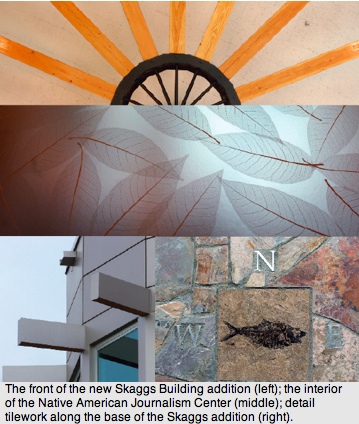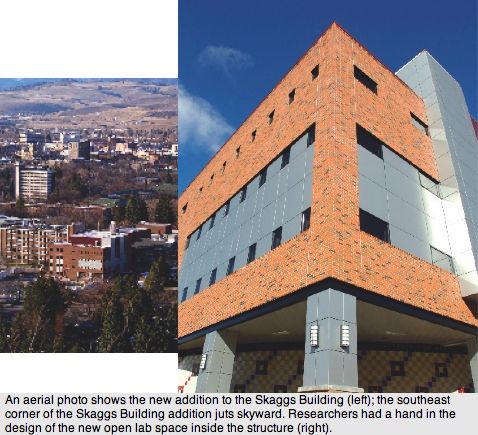UM's Edifice Complex
Campus Opens Two New Buildings this Spring By Alex Strickland
School of Journalism Dean Jerry Brown dresses like deans are supposed to dress. His tweed jackets and thin ties paired with sizable glasses and a bushy beard perfectly fit the academic stereotype. That is, until the last few years, when Brown got his hard hat.
The dean has been spotted more than a few times tooling around his current office—which hasn’t undergone construction for seventy years—in a white safety hat. He’s about to leave or just returning from the controlled calamity of construction across campus at Don Anderson Hall, the massive project Brown has overseen for the vast majority of his time at UM and the new home of the journalism school.
Years of construction detours, noisy equipment, and muddy sidewalks on two parts of campus will disappear all at once this spring, ushering in a new look and a new era for two of UM’s most well-respected and successful programs.
The College of Health Professions and Biomedical Sciences will unveil the new 60,000-square-foot addition to the Skaggs Building, and the School of Journalism will dedicate Don Anderson Hall, both during Commencement week.
The two buildings have been the centerpieces of a campus construction boom. President George Dennison frequently jokes in public that he has an edifice complex and that UM leaders aren’t happy unless at least one corner of campus is under construction at all times.
Moving on up
The Skaggs Building addition is the second major construction project on the building in the twenty-first century. An addition was finished on the then-Pharmacy/Psychology Building in 2000, and planning for the next phase began almost immediately, says David Forbes, dean of the College of Health Professions and Biomedical Sciences.
After the first addition, the building was renamed for drug-store-magnate-turned-philanthropist L.S. “Sam” Skaggs, whose ALSAM Foundation donated to the first and second construction projects. Other major private donors to the new addition include the Jack Poe family.
The new section primarily will be lab space for faculty and graduate student research, a burgeoning portion of the school’s raison d’être. “If you want an active faculty with a productive scholarship program, part of the equation is space,” Forbes says.

The research program has been so successful that in the 2006 rankings for total amounts of grants and contracts awarded, UM placed seventh among all pharmacy schools in the nation overall and fifth per capita. In both rankings UM was the highest-ranked program in states without medical schools.
“That’s tall cotton to be in,” Forbes says, cautioning that the new lab space won’t mean a leap in ranking, but rather will keep UM on pace with much larger, better-funded institutions.
“Everyone else is moving up, too,” he says. But it would be hard to argue that anyone has moved up farther or faster than UM.
Money for the addition is split down the middle, with $7 million coming from a federal grant and private donations and $7 million from general revenue bonds, meaning the school has to pay that money back over time.
Because of that, Forbes says the school is “not doubling in enrollment or anything,” but rather will be able to get researchers in more appropriate spaces and most likely will see an increase in productivity.
“It’s a really fun thing to go to national meetings and talk to deans,” Forbes says. “We used to be the bottom of the barrel and had accreditation difficulties; now we take a backseat to no one. It’s far better than I could have dreamed we would be,” he says.
New Building, Same Values
The day before the School of Journalism sets a new crop of journalists upon the world at commencement, it will dedicate a new home in the massive Don Anderson Hall, situated across the Oval from the structure built to house the program in 1936.
“I’m generally stunned by the beauty of it,” Brown says.
Don Anderson, for whom the building is named, is best known for organizing the Lee Enterprises’ purchase of a number of Montana newspapers from the Anaconda Copper Mining Company in 1959. Anderson, a Gallatin Valley native, spent his professional life in Wisconsin, but served as president of Lee Newspapers in Montana until it was folded into the main company. His obituary in 1978 referred to him as the “Abraham Lincoln of Montana journalism” for his work in liberating Montana papers from their corporate stranglehold.
The 57,000-square-foot building will bring the school’s print, photo, and radio-television departments back under the same roof for the first time in thirty years, a crucial move because of the increasingly multimedia nature of the industry, Brown says.

Funds for the facility have come almost exclusively from private donors, a feat that can in no small part be attributed to Brown’s Mark Twain-type personality and tireless efforts, though he deflects much of the credit.
“The timing was right,” he says. “As I look back over eight years, it’s a moving and even miraculous coming together of many positive forces. I just had the luck to be here when it all came together.”
Or, in a sentiment more typical of the Alabama-born dean: “There were lots of ripe apples when I got here,” he says. “I just shook the tree.”
A lot of apples, in fact. Brown says the donor list stands at about two hundred, with significant contributions coming from Anderson’s daughter and son-in-law, Sue and John Talbot of Missoula. John Talbot, former publisher of the Missoulian and longtime UM adjunct journalism faculty member, also was a Lee colleague of Anderson’s, as was Lloyd Schermer, who along with his wife, Betty, also made a substantial contribution to the building. Schermer is the former president of Lee Enterprises, which also made a sizeable donation, as did the Howard Charitable Foundation and philanthropist Margaret Tse.
The Pollner family, known for supporting an endowed visiting professorship each year in honor of their late son, J-school graduate T. Anthony Pollner, made a gift to fund a suite of offices for the Montana Kaimin in his memory.
Situated between Jeannette Rankin Hall and the Social Science Building, Anderson Hall is in a perfect location for budding journalism professionals, Brown says. “Journalists are supposed to be at a crossroads where human interests and institutional interests intersect.”
But multi-million dollar facility or not, Brown insists the school will differ very little from its beginning in Army surplus tents almost one-hundred years ago.
“The mission hasn’t changed since 1914,” he says. “We don’t want to become a school of delivery systems; this is a place for journalists to know their place in democracy.”
Much of the school’s illustrious history will make the cross-campus trek. The horseshoe table, a centerpiece in the memories of many J-school alums, will be in the new faculty conference room, albeit a few feet shorter. The enormous antique linotype machine and the friezes from the dean’s office also will adorn the new building.
The old Journalism Building will be a “swing space” for a few years to accommodate people displaced by other construction projects, says Bob Duringer, vice president for Administration and Finance. Eventually it, too, will be renovated.
But the students and faculty making the move remain the foundation of the program, Brown says.
“People are aware of the connection between the mission of this school and the quality of publications,” he says. “I believe this school sets a model for what professional schools ought to be doing.”
![]() Alex Strickland ’06 is a graduate of the UM School of Journalism. He currently works as a news editor with University Relations.
Alex Strickland ’06 is a graduate of the UM School of Journalism. He currently works as a news editor with University Relations.